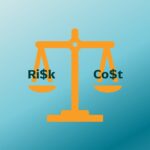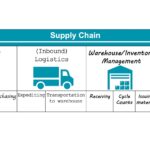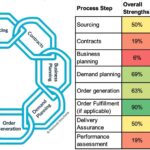E-auctions have come a long way since they were introduced in the late 1990s. What started as suppliers in a room writing bids on a clipboard became mailed floppy disks (yes, really), and then the web-based software options we know today. Along the way, we added more sophisticated tools, different types of e-auction, and more bid parameter options like overtime and bid decrements. In all of this evolution, one of the most useful, flexible, and complicated tools to use is bid transformation. Bid transformation answers the “what about…” question for all of that extra stuff e-auctions are so frequently accused of missing. Today we’re going to talk about what bid transformation is, how it works, how it can be used, and some cautions or guidelines on how to use it best.
What is Bid Transformation and How Does It Work?
Remember e-auctions are a chainsaw, not a hammer. And a good chainsaw has some settings you can play with to make it work better. Bid transformation is simply one of those settings, and not all e-auction platforms have this option. It is also sometimes called a bid penalty, discount, or bonus. Per the definition in my book, bid transformation is:
“Modifying a supplier’s bid on the buyer’s side to adjust for costs outside of the supplier’s control. This might include transition costs to change suppliers, differences in contract terms, or the cost of additional lead times.”
Let’s pick this definition apart a little and then provide an example. First, bid transformation modifies a supplier bid. This means either increasing or decreasing that bid for competition purposes. It’s a little like adding extra time to a project schedule or adding shipping charges to an online purchase. It can also be a discount where one supplier gets a bonus for value-added solutions, like offering a supplier team member to sit with the buyer’s team for additional support and resources. Second, a bid transformation is on the buyer’s side. This means a bid transformation is opaque to the supplier and they may not even know their bid is being transformed. There are reasons to communicate a transformation to suppliers and reasons not to, but the default setting is that suppliers are not aware they are competing based on a modified bid. Third, a bid transformation adjusts for costs outside of a supplier’s control. I’ll say a little more on this later, but a bid transformation should be based on something the supplier either won’t change (such as longer or shorter warranty) or can’t change (such as transition costs for the non-incumbent supplier or tariffs).
And now an example. In this example, the company is buying implementation services for a software upgrade. Three suppliers are qualified to do this work, and Supplier A is the incumbent supplier who has been supporting the existing software. The team runs an RFP and receives three bids for the implementation services:
Supplier A bids $1,000,000
Supplier B bids $950,000
Supplier C bids $1,200,000
Based on this, the award goes to Supplier B. But as you indirect procurement professionals know, things are never that simple for software implementation bids. Because Supplier A is the incumbent supplier, the technical team calculates a transition cost of $100,000 each for Supplier B and C based on needing to purchase additional plug-ins to connect to other system software, hire some code to be rewritten, and take an extra four weeks to help the new supplier understand the existing software environment. The team also estimates they will need to hire a temporary project manager to manage this project for twenty hours each week for twenty-six weeks at $200 per hour ($104,000 total). Supplier C offered to provide this resource in their bid at no additional charge. Here is a table showing all of these additions and transformations:

Note that with the transition cost and project manager cost added, the transformed bids are now:
Supplier A $1,104,000
Supplier B $1,154,000
Supplier C $1,300,000
If we were to move forward with these bids without an e-auction, Supplier A would be awarded based on total cost. But we do want to auction this to give Supplier B a chance to win the business and save our company money. In the auction, Supplier A would enter their $1,000,000 bid and see that they are bid rank 1. Supplier B would enter their $950,000 bid and see that they are bid rank 2. Supplier B would have to lower their bid below $900,000 to become bid rank 1 and potentially win the auction.
Bid Transformation Uses
The best use for bid transformation is to answer the “what about…” questions, which typically come from the technical team. What about tooling? What about transition costs? What about tariffs? What about fuel efficiency? What about warranty length or differences in contract terms? What about the timeframe to project completion? What about labor costs? The answer to all of these is they can be accounted for with bid transformations. Just as an e-auction is simply an echo of the old-fashioned post-RFP conversation asking suppliers to “sharpen the pencil,” a bid transformation is simply the calculation of a total cost of ownership. The magic and power of a bid transformation is that the software can allow suppliers to compete on total cost of ownership in real time.
Note some software options even allow bid transformations to be a percentage instead of a set amount, which is likely the best option for auctions involving tariffs/import taxes. Tariffs are an excellent bid transformation opportunity, especially when there are options from multiple countries competing for the business and those countries have different tariff rates. In that case, I would tell each supplier to not include tariffs in their bids and I would also let them know what rate I was using for their country’s tariff so they could validate.
Cautions and Practical Implications
As always, I like to try to include some cautions and practical implications for front-line practitioners. For bid transformations, here are those thoughts.
- Use true costs, not opportunity costs. It is incredibly tempting for technical teams to argue that if they are working with a certain supplier it will cost them more time or effort and then put that into a bid transformation. I always advise using bid transformation for “a check that will go out the door.” If the internal labor will cost additional overtime that is paid out to employees, it is a candidate for bid transformation. But if it is an opportunity cost where an employee could be working on an unrelated project instead of spending time with a new supplier, that is a slippery slope and I do not recommend using a bid transformation for that labor cost. Employees (especially salaried employees) will be paid regardless of their project, and unless there is a clear cost to one project vs. another, it probably isn’t a candidate for bid transformation.
- Calculate the bid transformation BEFORE bids come in. It’s magical how a bid transformation suddenly can make the technical team’s preferred supplier come out ahead when calculated after the initial bids come in. If you are going to use bid transformation, require that adjustment be calculated ahead of the RFP/RFI/e-auction. That doesn’t mean you can’t tweak it if there is new information (i.e. tariffs go up or down or steel commodity index prices spike), but have all the math in place before anyone sees the bids. This will help prevent bias in the results.
- Move bid transformations to the supplier side when possible. The definition for bid transformation includes modifying bids that are outside of a suppliers’ control. But as in our example, one supplier removed part of their bid transformation entirely by offering a project management resource. Even if you have to tell a supplier what the transformation is (i.e. $104,000 for a project manager resource or a 10% tariff), consider making them enter that amount. This increases the transparency of the auction, lets the supplier take responsibility for their costs to win the business, and they may even have access to extra resources outside the buyer’s knowledge. Perhaps they have an idle project manager coming off another project that they don’t mind assigning to this one to win the business. Perhaps they have onshore sites or Foreign-Trade Zone warehouses where they can mitigate tariff costs. Focus on the results you want and let the supplier provide the best method.
If you would like to talk about how bid transformation might be the lever you’re missing in your e-auction program, let’s chat. If you’d like to get these articles weekly straight to your inbox and never miss one, sign up for my newsletter.
My book, Transform Procurement: The Value of E-auctions is now available in ebook, paperback and even hardcover format: https://www.amazon.com/dp/B0F79T6F25




